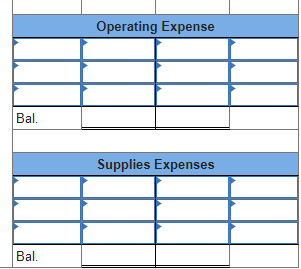Question
The following events apply to Complete Business Service in Year 1, its first year of operations: 1. Received $50,000 cash from the issue of common
The following events apply to Complete Business Service in Year 1, its first year of operations:
1. Received $50,000 cash from the issue of common stock.
2. Earned $45,000 of service revenue on account.
3. Incurred $20,000 of operating expenses on account.
4. Received $30,000 cash for performing services.
5. Paid $18,000 cash to purchase land.
6. Collected $32,000 of cash from accounts receivable.
7. Received a $8,000 cash advance for services to be provided in the future.
8. Purchased $1,900 of supplies on account.
9. Made a $17,500 payment on accounts payable.
10. Paid a $7,000 cash dividend to the stockholders.
11. Recognized $1,300 of supplies expense.
12. Recognized $6,000 of revenue for services provided to the customer in Event 7.
Required
A. Record the events in the general journal.
Complete this question by entering your answers in the tabs below.
Record the events in the general journal. (If no entry is required for a event, select "No journal entry required" in the first account field.)
General Journal Section Answer Options:
- No journal entry required
- Accounts payable
- Accounts receivable
- Cash
- Common stock
- Dividends
- Land
- Operating expenses
- Salaries expense
- Service revenue
- Supplies
- Supplies expense
- Unearned revenue

Required
B. Post the events to T-accounts.
Answer options for first and last columns of boxes for all accounts:
- 1
- 2
- 3
- 4
- 5
- 6
- 7
- 8
- 9
- 10
- 11
- 12




Required
C. Test the equality of the debit and credit balances of the T-accounts by preparing a trial balance.
Complete this question by entering your answers in the tabs below.
Answer options for "Account Titles" Column:
- Accounts payable
- Accounts receivable
- Cash
- Common stock
- Dividends
- Land
- Operating expenses
- Service revenue
- Supplies
- Supplies expense
- Unearned revenue

Step by Step Solution
There are 3 Steps involved in it
Step: 1

Get Instant Access to Expert-Tailored Solutions
See step-by-step solutions with expert insights and AI powered tools for academic success
Step: 2

Step: 3

Ace Your Homework with AI
Get the answers you need in no time with our AI-driven, step-by-step assistance
Get Started


